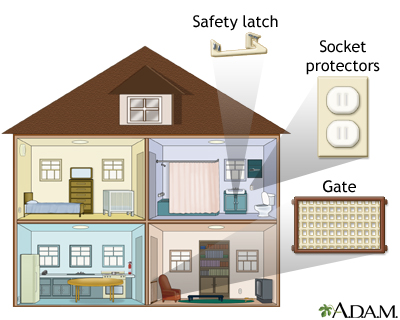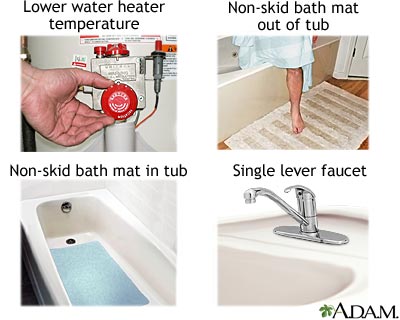Staying safe at home
Carbon monoxide safety; Electrical safety; Furnace safety; Gas appliance safety; Water heater safety
Images


I Would Like to Learn About:
Description
Like most people, you probably feel most secure when you are at home. But there are hidden hazards lurking even at home. Falls and fires top the list of avoidable threats to your health.
Have you taken steps to make your home as safe as it can be? Use this checklist to uncover potential problems.
General Safety Advice
You should:
- Keep a well-stocked first aid kit in your home.
- Keep a list of emergency numbers near your telephone. Include the local numbers for fire, police, utility companies, and local poison control centers (800) 222-1222.
- Make sure your house number is easy to see from the street, in case an emergency vehicle needs to look for it.
Avoiding Falls
Falls are one of the most common causes of injury in the home. To prevent them:
- Keep the walkways outside and inside your home clear and well lit.
- Put lights and light switches at the top and bottom of the stairs.
- Remove loose wires or cords from areas you walk through to get from one room to another.
- Remove loose throw rugs.
- Fix any uneven flooring in doorways.
Fire Safety
Learn fire safety inside the home and outside the home:
- Put gas and charcoal grills well away from your home, deck railings, and out from under eaves and overhanging branches.
- Keep tree leaves and needles off your roof, deck, and shed.
- Move anything that can burn easily (mulch, leaves, needles, firewood, and flammable plants) at least 5 feet away from the outside of your home. Contact your local Cooperative Extension service for a list of flammable and fire-safe plants in your area.
- Trim branches that hang over your house and prune branches of large trees up to 6 to 10 feet from the ground.
If you use a fireplace or a wood stove:
- Burn only dry seasoned wood. This helps prevent soot buildup in the chimney or flue, which can cause chimney fires.
- Use a glass or metal screen in front of your fireplace to keep sparks from popping out and starting a fire.
- Make sure the door latch on the wood stove closes properly.
- Have a professional check your fireplace, chimney, flue, and chimney connections at least once a year. If needed, have them cleaned and repaired.
Carbon Monoxide Safety
Carbon monoxide (CO) is a gas you cannot see, smell, or taste. Exhaust fumes from cars and trucks, stoves, gas ranges, and heating systems contain CO. This gas can build up in closed spaces where fresh air cannot get in. Breathing too much CO can make you very ill and can be deadly. To prevent CO poisoning in your home:
- Put a CO detector (similar to a smoke alarm) in your home. Detectors can be on each floor of your home. Place an additional detector near any major gas-burning appliances (such as a furnace or water heater).
- If the detector plugs into an electrical outlet, make sure it has a battery backup. Some alarms detect both smoke and CO.
- Make sure that your home heating system and all your appliances are all working correctly.
- Do not leave a car running in a garage, even with the garage door open.
- Do not use a generator inside your house or garage or just outside a window, door, or vent that goes into your house.
Electrical Safety
All electrical outlets near water should be protected by Ground-Fault Circuit Interrupters (GFCI). They are required in unfinished basements, garages, outdoors, and anywhere near a sink. They interrupt the electrical circuit if someone comes in contact with electrical energy. This prevents a dangerous electrical shock.
You should also:
- Check for loose or frayed wires all on electrical devices.
- Make sure there are no electrical cords under rugs or across doorways. Do not put cords in areas where they can be walked on.
- Have an electrician check any plugs or outlets that feel warm.
- Do not overload outlets. Plug in only one high-wattage appliance per outlet. Check that you do not exceed the amount allowed for a single outlet.
- Use light bulbs that are the correct wattage.
Make sure electric outlets are safe for children. Add outlet plugs or covers that prevent children from sticking items into the receptacle. Move furniture in front of plugs to prevent them from being pulled out.
Appliance Safety
Make sure that all of your household appliances are in good working condition. Check that all of your electrical appliances, cords, and tools have been tested by an independent testing laboratory, such as UL or ETL.
Gas appliances:
- Have any gas-burning appliances such as hot water heaters or furnaces checked out once a year. Ask the technician to be sure appliances are vented properly.
- If the pilot light goes off, use the shutoff valve on the appliance to turn off the gas. Wait several minutes for the gas to drift away before trying to relight it.
- If you think there is a gas leak, get everyone out of the house. Even a small spark can cause an explosion. Do not light any lighters, turn on electrical switches, turn on any burners, or use other appliances. Do not use cell phones, telephones, or flashlights. Once you are well away from the area, call 911 or the local emergency number, or the gas company right away.
Furnace:
- Keep the air supply vent clear of obstructions.
- Replace the furnace filter at least every 3 months when in use. Change it every month if you have allergies or pets.
Water heater:
- Set the temperature no higher than 120 degrees Fahrenheit (48.9 degrees Centigrade).
- Keep the area around the tank free from anything that can catch fire.
Dryer:
- Clean the lint basket after every load of laundry.
- Use the vacuum attachment to clean inside the dryer vent once in a while.
- Only use the dryer when you are home; turn it off if you go out.
Bathroom
Bathroom safety is particularly important for older adults and children. General tips include:
- Put non-slip suction mats or rubber silicone decals in the tub to prevent falls.
- Use a non-skid bath mat outside the tub for firm footing.
- Consider using a single lever on your sink faucets and shower to mix hot and cold water together.
- Keep small electrical appliances (hair dryers, shavers, curling irons) unplugged when not in use. Use them away from sinks, tubs, and other water sources. Never reach into water to get a fallen appliance unless it is unplugged.
Firearm Safety
Make sure not to keep loaded firearms in your home if you have children or adolescents. There is a high risk of accidental gun injuries, suicide, and homicide if you have guns in your home.
If you think that keeping a gun is necessary, you can reduce the risk of injury by taking these steps:
- Always keep the guns unloaded and locked safely.
- Make sure your children do not have access to the keys of the gun locker.
- Never keep loaded and unlocked guns in the car or any place that can be accessed by your children.
- Never unlock safety catch, if you are using the gun for target practice or hunting, until you are ready to shoot it.
- Never allow your child or teen to shoot for fun unsupervised, as it may turn into a fatal accident.
References
Centers for Disease Control and Prevention website. Teens: safety in the home & community. www.cdc.gov/parents/teens/safety.html. Updated May 14, 2024. Accessed June 25, 2024.
Centers for Disease Control and Prevention website. Young children: safety in the home & community. www.cdc.gov/parents/children/safety-in-the-home-and-community.html. Updated May 14, 2024. Accessed June 25, 2024.
Healthychildren.org website. American Academy of Pediatrics Council on injury, violence and poison prevention. Guns in the home: how to keep kids safe. www.healthychildren.org/English/safety-prevention/at-home/Pages/Handguns-in-the-Home.aspx#. Updated September 30, 2023. Accessed February 16, 2024.
National Fire Protection Association website. Carbon monoxide safety tip sheet. www.nfpa.org/downloadable-resources/safety-tip-sheets/carbon-monoxide-safety-tip-sheet. Updated 2017. Accessed February 16, 2024.
National Home Security Alliance. Safety at home: 10 common safety hazards around the house. staysafe.org/safety-at-home-10-common-safety-hazards-around-the-house. Updated 2024. Accessed February 16, 2024.
US Consumer Product Safety Commission website. Safety education. www.cpsc.gov/Safety-Education. Accessed February 16, 2024.
US Fire Administration website. Home is where the heart is: don't let your world go up in smoke. www.usfa.fema.gov/downloads/fief/home_fire_protection_plan.pdf. Accessed February 16, 2024.
BACK TO TOPReview Date: 2/8/2024
Reviewed By: Linda J. Vorvick, MD, Clinical Professor, Department of Family Medicine, UW Medicine, School of Medicine, University of Washington, Seattle, WA. Also reviewed by David C. Dugdale, MD, Medical Director, Brenda Conaway, Editorial Director, and the A.D.A.M. Editorial team.

Health Content Provider
06/01/2025
|
A.D.A.M., Inc. is accredited by URAC, for Health Content Provider (www.urac.org). URAC's accreditation program is an independent audit to verify that A.D.A.M. follows rigorous standards of quality and accountability. A.D.A.M. is among the first to achieve this important distinction for online health information and services. Learn more about A.D.A.M.'s editorial policy, editorial process and privacy policy. A.D.A.M. is also a founding member of Hi-Ethics. This site complied with the HONcode standard for trustworthy health information from 1995 to 2022, after which HON (Health On the Net, a not-for-profit organization that promoted transparent and reliable health information online) was discontinued. |
The information provided herein should not be used during any medical emergency or for the diagnosis or treatment of any medical condition. A licensed medical professional should be consulted for diagnosis and treatment of any and all medical conditions. Links to other sites are provided for information only -- they do not constitute endorsements of those other sites. © 1997- 2025 A.D.A.M., a business unit of Ebix, Inc. Any duplication or distribution of the information contained herein is strictly prohibited.
